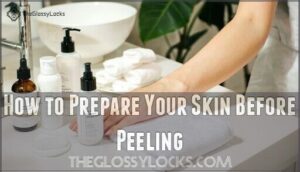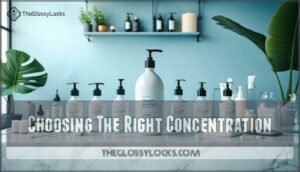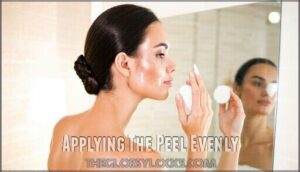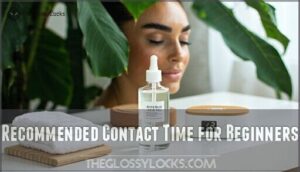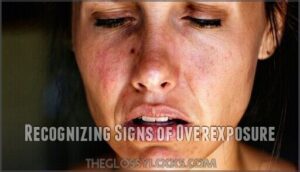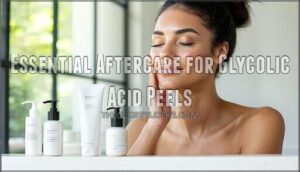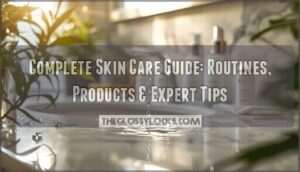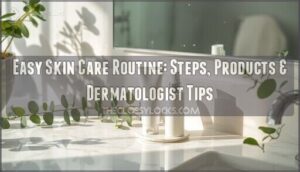This site is supported by our readers. We may earn a commission, at no cost to you, if you purchase through links.

Double cleanse your face, skip retinoids for a week, and use petrolatum around sensitive spots like lips and eyes.
Apply the peel evenly using the right concentration for your skin. Rinse off when time’s up—think clock, not marathon.
Afterwards, grab a fragrance-free moisturizer and go heavy on SPF. Skip makeup and harsh products for a day or two.
Mastering glycolic acid peels takes patience, but your skin’s glow-up is worth the effort. There’s more to perfecting your routine just ahead.
Table Of Contents
- Key Takeaways
- What is a Glycolic Acid Peel?
- Who Should Use Glycolic Acid Peels?
- How to Prepare Your Skin Before Peeling
- Step-by-Step Glycolic Acid Peel Application
- How to Neutralize and Remove The Peel
- Essential Aftercare for Glycolic Acid Peels
- How Often Should You Use Glycolic Peels?
- Frequently Asked Questions (FAQs)
- How do I use a glycolic acid peel correctly?
- Are banana peel acidic?
- How does a glycolic acid peel work?
- Is a glycolic acid peel right for You?
- What are the pros and cons of a glycolic peel?
- How much does a glycolic peel cost?
- Who’s a good candidate for a glycolic peel?
- How should you prepare for a glycolic peel?
- What happens during a glycolic peel treatment?
- What can you expect after a glycolic peel?
- Conclusion
Key Takeaways
- Start with a patch test 24 hours before your first peel to check for allergic reactions, then discontinue retinoids for a week and double cleanse your face before application
- Apply the peel evenly with the right concentration for your skin type (beginners should use 5-8% for 15-30 seconds), avoiding eyes and lips, then neutralize and rinse thoroughly when time’s up
- Follow strict aftercare by using fragrance-free moisturizer, applying SPF 30+ daily, and avoiding makeup and harsh products for 1-2 days while your skin recovers
- Space treatments appropriately based on your skin type—sensitive skin needs monthly peels, while oily skin can handle every 2 weeks, with most people seeing results after 5-8 sessions
What is a Glycolic Acid Peel?
A glycolic acid peel uses a chemical solution to exfoliate the top layer of your skin, revealing smoother and more even texture.
It’s a safe, evidence-based treatment for acne, hyperpigmentation, and early signs of aging when used as directed, providing a solution that is also effective.
How Glycolic Acid Works
Think of glycolic acid as your skin’s reset button.
Hit reset on your complexion—glycolic acid clears the canvas so your best skin can shine through
As an alpha hydroxy acid, it penetrates the surface, dissolving dead cells through chemical exfoliation and triggering cell renewal.
This process helps loosen congestion and supports collagen boost, creating a smoother canvas over time, all thanks to its AHA effects.
Glycolic acid peels deliver these clinical, controlled results.
Key Benefits for Skin
Achieving smoother skin starts with Glycolic Acid Peels Benefits. Here’s why this alpha hydroxy acid offers real results:
- Boosts collagen and supports skin rejuvenation.
- Increases cell renewal for a fresher look.
- Addresses hyperpigmentation and uneven tone.
- Helps with acne treatment and controls breakout cycles.
A glycolic peel is your ticket to confident, clearer skin.
Common Skin Concerns Treated
After learning about glycolic acid’s effects, let’s tackle the main problems it solves.
Glycolic Acid Peel Treatment is a backbone for Acne Treatment, fading stubborn hyperpigmentation, and evening out melasma patches.
Over time, you’ll notice sun damage softening and fine wrinkles smoothing out.
That’s how this peel transforms common frustrations into visible improvements.
Understanding skin care acids is essential for maximizing the benefits of glycolic acid peel treatments.
—————-:
————–:
——————:
The table summarizes the effects of glycolic acid on various skin conditions, including Acne, Hyperpigmentation, and Sun Damage.
This information helps in understanding how glycolic acid peel treatments can lead to a smoother texture and brighter tone.
Who Should Use Glycolic Acid Peels?
You might benefit from glycolic acid peels if you have acne, hyperpigmentation, or fine lines, but not everyone’s skin is a good match for this treatment.
It’s important to review your medical history and consult a skincare professional to avoid complications.
Suitable Skin Types and Conditions
Glycolic acid peels fit nearly every skin type, from dry skin longing for radiance to acne prone or hyperpigmentation struggles.
Even sensitive skin can join—with a patch test and low concentration for safety.
These chemical peels work smoothly into your skin care routine, offering gentle exfoliation without rough scrubs, making mastery of skin exfoliation totally attainable.
For best results, consider consulting a professional for chemical peels treatment, which is crucial for optimal results.
Contraindications and Warnings
Your skin’s unique blueprint matters—some should steer clear of a glycolic peel.
Avoid use if you’ve had:
- Recent isotretinoin use (within 6 months)
- History of keloids or acne scars
- Prone to allergic reactions or skin sensitivity
- Darker skin tones risking hyperpigmentation
- Persistent melasma or postinflammatory hyperpigmentation
Consult warnings for maximum safety and best results.
Consulting a Skincare Professional
Before jumping in, think about a skin consultation for customized chemical peel directions. Professional guidance matters—especially with past sensitivities or prescription use.
Personalized skin advice is the key to safer, smarter chemical peels—let an expert guide your next glow
A dermatologist’s advice helps spot risks you might overlook, steering you away from trouble. Skincare planning, founded on expert opinion, gives you the steering wheel.
Glycolic acid peel isn’t one-size-fits-all. Here’s a snapshot for reference:
| Question Type | When to Ask | Why It Matters |
|---|---|---|
| Sensitivity Concerns | Previous reactions | Avoids complications |
| Medication History | Ongoing prescriptions | Prevents dangerous combos |
| Treatment Goals | Clarify expectations | Guarantees realistic outcomes |
| Patch Test Results | Before application | Guides next steps safely |
| Follow-Up Scheduling | After first session | Monitors skin adjustments |
The table provides a clear overview of what to consider when planning a chemical peel treatment, ensuring that you cover all necessary aspects, from sensitivity concerns to follow-up scheduling, to achieve the best results.
How to Prepare Your Skin Before Peeling
Before you use a glycolic acid peel, it’s important to prep your skin using proven steps to minimize irritation and boost results.
Start by performing a patch test, stop prescription creams, and double cleanse to create an ideal barrier for safe application.
Performing a Patch Test
Before moving on to Glycolic Acid Peel Therapy, don’t put your skin’s trust to chance—run a patch test first.
Dab Glycolic Acid on a hidden spot, like your jawline or behind your ear. Watch for allergic reactions: redness, swelling, or burning.
Wait 24 hours. No issues? You’re likely ready to follow Chemical Peel Directions without worries about unexpected skin sensitivity.
Understanding proper skin patch tests is essential for safe peel application and avoiding allergic reactions.
Discontinuing Prescription Skincare
Before starting a Glycolic Acid Peel, set aside prescription skincare like retinoids or Accutane for at least a week.
This helps avoid Skin Adjustment complications or Medication Rebound effects.
Let your skin adjust—think of it as giving your face a breather.
Switch to gentle Topical Substitutes to ease Skincare Withdrawal and reduce irritation risk during chemical peels or prescription alternatives.
Double Cleansing and Prepping Skin
After stopping prescription skincare, it’s time for a thorough skin prep.
Double cleansing with an acidic pH balance cleanser removes oil and makeup, setting the stage for the glycolic peel.
Use gentle exfoliation methods and avoid abrasive scrubs.
Afterward, apply skin toners if prescribed.
Proper skin exfoliation helps chemical peels like glycolic acid work evenly, minimizing irritation and improving results.
Following a consistent basic facial skin care routine is vital for healthy skin health before undergoing such treatments.
Protecting Sensitive Areas
Shielding sensitive zones is essential before a glycolic acid peel—think of it as laying down sandbags before a flood.
For Irritation Prevention and Skin Barriers, try these gentle techniques:
- Apply petrolatum to lips, nostrils, and eye area
- Use cotton pads as Eye Care shields
- Avoid active breakouts
- Minimize peel near mouth corners
- Protect any inflamed skin
Chemical peels demand precision.
Step-by-Step Glycolic Acid Peel Application
You’ll follow precise steps to apply glycolic acid safely, ensuring even coverage and minimizing irritation. Stick to recommended guidelines so your skin barrier stays protected throughout the process.
Choosing The Right Concentration
Choosing the right Concentration Levels in Glycolic Acid Peels makes all the difference.
Balance Peel Strength with your Skin Tolerance—beginners start with 5–8% Acid Percentage, while advanced users might reach 20%.
Higher Treatment Depths demand caution.
Let’s keep things precise: Understanding skin care basics is essential for effective peel application.
| Glycolic Peel | Acid Percentage | Skin Tolerance |
|---|---|---|
| Mild | 5–8% | Sensitive skin |
| Moderate | 10–20% | Normal skin |
| Advanced | 20–30% | Experienced users |
| Professional | 30–50% | By physicians only |
| Deep | 50–70% | Specialty clinics |
Applying The Peel Evenly
Once you’ve picked your ideal Glycolic Acid Peel strength, it’s time for even coverage.
Use firm, horizontal and vertical peel motions to sweep the solution across your face, keeping Application Tips in mind.
Cheeks go first, nose and lips last to minimize irritation.
Solid Skin Prep guarantees smooth results—think of your technique as painting a masterpiece with Alpha Hydroxy Acids.
Understanding the proper acid peel benefits is vital for effective skin care routines and to achieve the desired acid peel benefits.
Recommended Contact Time for Beginners
After smooth, even application, your Initial Exposure to glycolic acid peels should be brief.
For most, a Sensitivity Test will reveal your Skin Tolerance—usually 15 to 30 seconds is enough.
Keep the Peel Duration short. Setting proper Contact Limits helps reduce irritation.
With chemical peels like a glycolic acid peel, patience beats rushing for quick results every time.
Avoiding Eyes and Sensitive Zones
Someone wise said, “Don’t let your Glycolic Acid Peel wander.”
Use facial mapping to steer clear of the delicate eye area and lips, which are magnets for irritation.
Gentle application on thicker skin zones allows for effective results.
Sensitive skin begs for caution, so prioritize eye protection and be mindful—chemical peels are skin care products, not magic wands for every inch.
How to Neutralize and Remove The Peel
You’ll need to neutralize the glycolic acid peel promptly to avoid irritation, using a dedicated neutralizing solution or cool water.
Take care to rinse thoroughly and pat your skin dry, ensuring all residue is removed.
Recognizing Signs of Overexposure
When your skin starts talking back after a glycolic acid peel, don’t ignore it.
Watch for these Redness Signs and Skin Irritation markers:
- Stinging or burning that lingers, beyond mild tingling
- Persistent redness or warmth lasting past two weeks
- Flaking, rough texture, or sandpaper feel
- Sudden dark spots hinting at Postinflammatory Hyperpigmentation
Recognizing Overexposure Symptoms means avoiding deeper sensitivity reactions and potential Peel Burn.
To minimize risks, consider consulting glycolic acid peels guidelines for proper pre and post treatment care.
Proper Neutralization Techniques
If you sense tingling or see redness, it’s time to neutralize. Use a neutralizer solution to halt the Alpha Hydroxy Acids, helping your skin’s pH balance return to baseline.
This step guarantees calibration after the Glycolic Acid Peel, reducing risk of irritation and optimizing post peel care.
| Term | What It Means |
|---|---|
| pH Balance | Skin acidity equilibrium |
| Neutralizer Use | Stops chemical peels action |
| Rinse Techniques | Removes acid residue |
| Skin Calibration | Restores baseline balance |
| Post Peel Care | After-treatment steps |
Rinsing and Patting Skin Dry
After you neutralize the Glycolic Acid Peel, rinse thoroughly with cool water.
Avoid hot water to protect the skin barrier. Skin patting is key—grab a soft towel and gently blot, never rub, maintaining the skin’s moisture balance.
This approach is true for all chemical peels. Effective drying techniques after gentle cleansing boost recovery and reduce irritation from Glycolic Acid Peels.
Effective drying techniques after gentle cleansing are crucial for the skin’s health. Maintaining the skin’s moisture balance is essential for its overall well-being.
Essential Aftercare for Glycolic Acid Peels
After a glycolic acid peel, you’ll need to focus on gentle care to support your skin’s recovery and protect its barrier.
Use a soothing moisturizer, strict daily sun protection, and avoid anything that could cause irritation.
Soothing and Moisturizing Skin
After rinsing off your glycolic peel, reach for a gentle cleanser—no need to scrub or stress.
Skin hydration is your next goal. Smooth on a calming cream or soothing gel packed with hyaluronic acid.
Light moisturizer tips: less is more, especially right after a peel. Stick with fragrance-free formulas, avoid irritants, and prioritize barrier-repair skincare.
Using a gentle skin care product, such as those found in gentle skin routines, can help soothe and calm the skin.
Sun Protection and SPF Use
After a Glycolic Acid Peel, think of sun protection as armor.
Use mineral sunscreen—zinc oxide or titanium dioxide—for maximum UV protection.
Choose SPF 30 or higher for daily routine, even indoors, to minimize skin cancer risk.
Generous coverage defends against sun damage.
Reapply SPF every two hours outdoors.
Don’t let negligence unravel your skin’s hard-earned progress.
Avoiding Irritants and Makeup Tips
After shielding your skin from UV rays, focus on an irritant free post peel routine. Make gentle choices. Sensitive skin care and makeup go hand-in-hand after chemical peels.
Try these:
- Pick gentle makeup for fragile skin
- Avoid exfoliants, acids, and retinoids
- Use fragrance-free, non-comedogenic basics
- Double cleanse for complete makeup removal
- Choose hydrating, barrier-protecting products
Following a non irritating skincare routine is essential for maintaining healthy skin after chemical peels, and it requires a careful selection of gentle and non-comedogenic products.
Managing Peeling and Redness
When you spot flaking or redness after a Glycolic Acid Peel, don’t panic—your skin’s just doing a little spring cleaning.
Reach for fragrance-free moisturizers to boost Skin Soothing and help with Peeling Care. Skip exfoliants to support Post Peel Recovery and Redness Reduction.
Here’s a quick chart:
| Symptom | Do | Don’t |
|---|---|---|
| Peeling | Apply moisturizer | Scrub |
| Redness | Use cold compress | Touch often |
| Itching | Take antihistamine | Scratch |
| Dryness | Hydrate skin | Dehydrate |
| Irritation | Rest skin | Over-treat |
How Often Should You Use Glycolic Peels?
You’ll want to space out your glycolic acid peels, since your skin needs time to recover between treatments and prevent over-exfoliation.
Determining the right frequency depends on your skin type and treatment goals, so following evidence-based guidelines helps minimize side effects and optimize results.
Treatment Frequency by Skin Type
After cooling off with gentle aftercare, let’s talk timing—your skin type controls the reins. For Sensitive Skin, start monthly. Oily Skin tolerates Glycolic Acid Treatment every 2 weeks. If you’re Normal or Combination Skin, try every 2–3 weeks.
- Chemical Peels must never overlap.
- Dry Skin may need more recovery.
- Always patch test.
Course Duration for Best Results
Once you’ve found the right Treatment Frequency, stick with your peel scheduling.
Most people see results after 5–8 Glycolic Acid Peel sessions, spaced every other week for proper skin recovery.
This session interval helps your skin rebuild and adjust, reducing risk, and allows for steady tracking of your result timeline closely—chemical peels work best with steady, well-timed Glycolic Acid treatment.
Maintenance and Follow-Up Sessions
Once your course wraps up, Session Scheduling becomes your new best friend.
Set Glycolic Acid Peel maintenance every 4–6 weeks, depending on how your skin feels and professional advice.
Stick to this Peel Frequency for ideal Treatment Outcomes.
Prioritize Skin Recovery and Follow Up Care—hydration, sun protection, and gentle routines keep skin smooth between Chemical Peel Treatment sessions.
Frequently Asked Questions (FAQs)
How do I use a glycolic acid peel correctly?
Test a small patch first, then double cleanse and prep your skin.
Apply the peel evenly, avoiding eyes and lips, and rinse after 15–30 seconds.
Expect tingling—redness or dryness is normal.
Moisturize and wear SPF afterward.
Are banana peel acidic?
Banana peels have a mildly acidic pH, usually around
That’s not enough to act like an acid peel, but you’ll notice their gentle nature if you ever use one for a DIY skin remedy or composting.
How does a glycolic acid peel work?
When you brush on a glycolic acid peel, it dissolves dead skin cells on the surface, speeding up cell turnover and boosting collagen.
Think of it as a reset button, revealing smoother, brighter skin underneath—no magic required, with glycolic acid being the key to this process.
Is a glycolic acid peel right for You?
Every rose has its thorn.
Glycolic acid peels can brighten, reduce acne, and renew skin, but they’re not for everyone.
Sensitive, dark, or compromised skin needs extra caution—start low, increase slowly, and always prioritize safety.
What are the pros and cons of a glycolic peel?
You’ll see brighter, smoother skin and faded dark patches, but there’s a trade-off—risk of redness, flaking, or lasting spots, especially if your skin’s darker.
Get ready to baby your face and skip the sunshine after!
How much does a glycolic peel cost?
Ever wondered if clear skin breaks the bank?
A professional glycolic peel usually costs $80–$250 per session, depending on concentration and location.
Home-use kits are cheaper, but safety, potency, and results vary, so research before starting.
Who’s a good candidate for a glycolic peel?
If you’ve got mild acne, dull skin, or sun damage, a glycolic peel may suit you.
Not for those with recent isotretinoin use, frequent cold sores, or a tendency for keloids—ask your dermatologist first.
How should you prepare for a glycolic peel?
Think of prepping for a peel like tuning up an engine—start with a patch test to spot sensitivities.
Cleansing is crucial, so cleanse twice with an acidic pH wash, and skip exfoliants.
To ensure the best results, avoid sunbathing or using retinoids, and remember to hydrate your skin.
What happens during a glycolic peel treatment?
You’ll feel a gentle tingle as the glycolic acid goes on with a brush in smooth, even strokes.
After a short wait, the solution’s neutralized and rinsed, revealing fresh, brighter skin ready for action.
What can you expect after a glycolic peel?
You’ll experience temporary stinging, then expect 7-10 days of flaking and dryness.
Redness may persist for 2-4 weeks.
New skin emerges more sensitive to sun, requiring strict SPF protection and gentle skincare during recovery.
Conclusion
Think of glycolic acid peels as your skin’s personal trainer—they’ll push you to glow, but only if you respect the process.
Learning how to use glycolic acid peel correctly means following each step carefully, from patch testing to proper aftercare.
Start conservatively with lower concentrations and shorter contact times. Your skin will tell you what it can handle through its response.
Remember that consistency trumps intensity every time. With patience and the right technique, you’ll achieve that coveted radiant complexion safely.


